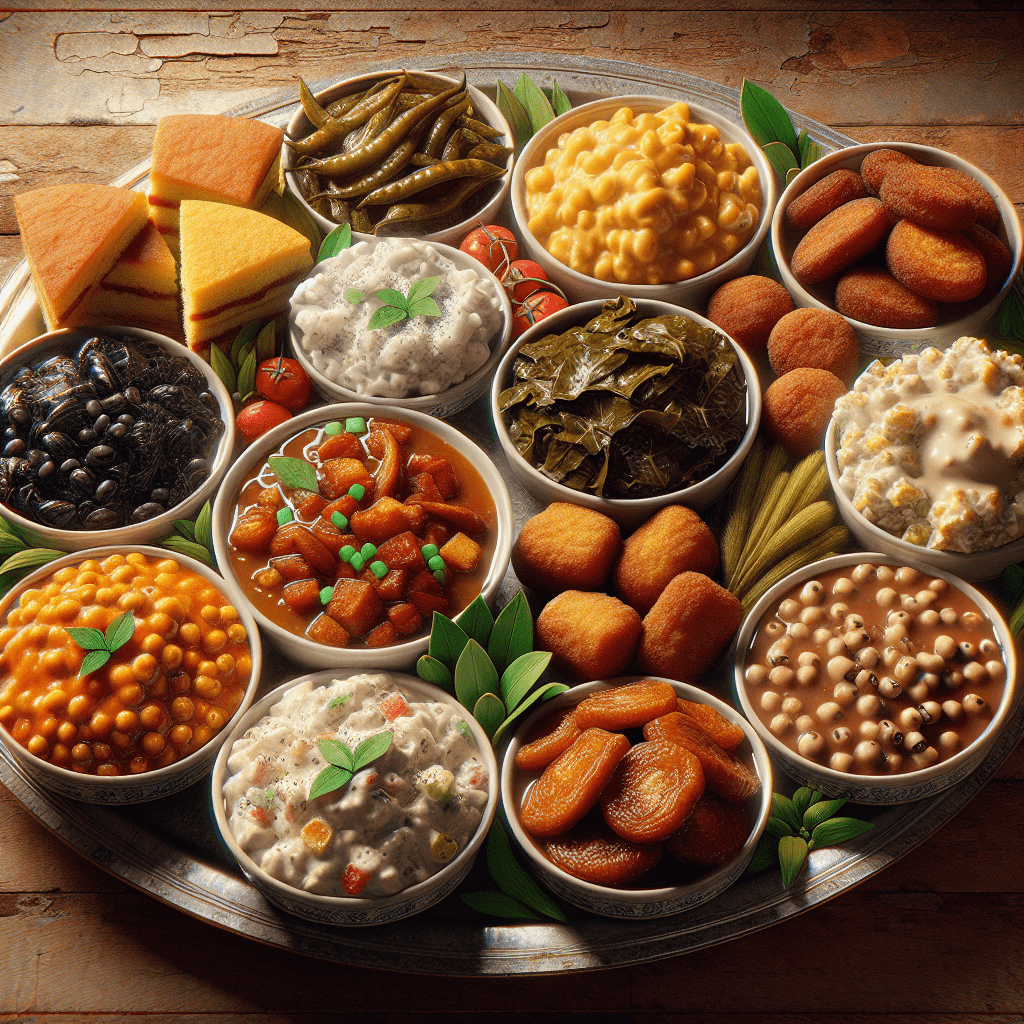Soul food represents much more than just a culinary tradition; it embodies a vibrant tapestry interwoven with history, culture, and community.
Rooted in the African American experience, soul food has evolved over generations, adapting to changing tastes while still honoring its deep historical roots.
This article aims to delve into the origins of soul food, highlighting its classic dishes, and examining how modern interpretations are reshaping this cherished cuisine.
We invite you to join us as we explore the rich history of soul food and its lasting influence on American culture and dining.
What Is Soul Food?
Soul food represents a vibrant and rich culinary tradition that is deeply embedded in African American culture. Its comforting and hearty dishes have been passed down through generations, evolving from humble beginnings into modern classics.
This cuisine includes a variety of recipes that showcase Southern cooking, often highlighting beloved staples such as fried chicken, collard greens, and cornbread. These dishes have become essential to community gatherings and family meals.
The flavors and cooking techniques used in soul food reflect the cultural identity and food heritage of the African American experience, celebrating the culinary practices that have significantly shaped American cuisine over the years.
Origins of Soul Food
The origins of soul food can be traced back to the rich and complex history of African American culture. Enslaved individuals adapted traditional African cooking techniques to make use of the local ingredients that were available to them, resulting in a unique culinary legacy.
This food history demonstrates how humble beginnings influenced traditional dishes that became staples in the Southern diet, showcasing resilience and creativity in the face of adversity. Over the years, these dishes have transformed into cherished recipes that embody the essence of community and family gatherings, highlighting the profound connection between food and cultural identity.
How Did Soul Food Come to Be?
Soul food emerged from the culinary practices of African Americans, blending African traditions with the ingredients available in the Southern United States. This fusion has created a rich tapestry of flavors and cooking methods that define this cherished cuisine.
Deeply influenced by a history of oppression and the need for survival, these dishes were often prepared during community gatherings, where families and friends came together to share meals and preserve their culinary heritage.
The roots of soul food can be traced back to West African cooking techniques, which are characterized by bold seasonings and the slow cooking of meats and vegetables. Throughout the harsh realities of slavery, enslaved individuals displayed remarkable creativity and resourcefulness by transforming discarded ingredients into flavorful dishes that not only nourished their bodies but also served as a means of cultural expression. This allowed communities to maintain a vital connection to their African ancestry.
Events such as Sunday dinners and communal cookouts became treasured traditions, fostering connections through the shared enjoyment of hearty staples like:
- Collard greens
- Black-eyed peas
- Cornbread
- Fried chicken
Each of these dishes tells a story of resilience and unity.
What Influenced the Development of Soul Food?
The development of soul food has been shaped by a variety of influences, particularly the rich cultural exchanges among African, Native American, and European cuisines. This blending brought together a diverse array of ingredients and cooking techniques, which contributed to soul food’s distinct identity.
The ethnic diversity inherent in Southern cuisine has played a crucial role in the evolution of soul food, as traditional culinary customs were adapted and innovated, resulting in a complex flavor profile that is both unique and deeply cherished.
This fusion of culinary traditions has led to the incorporation of local ingredients like okra, collard greens, and cornbread—staples that illustrate the resourcefulness that emerged from the historical context of soul food.
Cooking techniques have evolved over generations, reflecting the practical needs of communities while also celebrating creativity. Each adaptation tells a story of resilience and ingenuity, honoring the heritage of those who have passed down these recipes through time.
Through this ongoing cultural exchange and the dynamic nature of food customs, soul food continues to flourish, resonating both within its originating communities and beyond.
The Evolution of Soul Food
The evolution of soul food presents a fascinating journey of culinary creativity. Traditional recipes have been adapted over time to accommodate changing tastes and influences, all while staying true to their roots in African American culture.
This includes the incorporation of new ingredients and the use of modern cooking techniques. As a result, soul food has maintained its reputation as a beloved comfort food throughout America.
This evolution highlights the rich layers of flavor and tradition that characterize soul food, connecting generations through shared dining experiences and the simple pleasure of comforting meals.
How Did Soul Food Change Over Time?
Over time, soul food has experienced significant transformations, enriched by culinary innovations and the blending of various regional flavors throughout the South.
Traditional dishes, such as gumbo, jambalaya, and black-eyed peas, have evolved to include new ingredients and techniques. This evolution has broadened the appeal of soul food beyond its original context while still honoring its deep roots in African American culture.
This transformation reflects not only the changing preferences of today’s diners but also highlights the creativity of chefs who skillfully blend classic recipes with modern culinary practices.
In vibrant cities like Atlanta and New Orleans, the integration of global ingredients has resulted in exciting new interpretations, allowing the traditional flavors to shine while attracting a wider audience.
Regional variations contribute unique characteristics to the dishes, as each area introduces its own local produce and cooking styles. Consequently, soul food continues to thrive, celebrating its rich history and dynamic future through diversification and innovation.
What New Ingredients Were Introduced to Soul Food?
As soul food has evolved, a diverse array of new ingredients has been introduced, often sourced from local markets and seasonal offerings. This evolution enriches the cuisine with fresh flavors and textures.
The incorporation of these new ingredients reflects changing tastes and aligns with sustainable cooking practices that emphasize food preservation and farm-to-table principles. This ensures that soul food remains both vibrant and relevant.
By embracing locally sourced vegetables, grains, and proteins, cooks have the opportunity to experiment with dishes that honor traditional recipes while incorporating fresh seasonal produce. For example, the addition of heirloom tomatoes or locally grown greens brings a delightful burst of flavor that enhances classic recipes.
Similarly, seasonal berries and fruits introduce a touch of sweetness, elevating traditional desserts and offering a unique twist on beloved favorites.
This innovative approach not only enhances the overall taste experience but also strengthens community connections by supporting local farmers and their harvest cycles.
How Did Soul Food Spread Across the United States?
The spread of soul food across the United States can be traced to several key factors, notably the migration of African Americans during the Great Migration. This movement brought traditional dishes to new regions and cities, integrating them into the larger American culinary landscape.
Soul food restaurants emerged as cultural hubs, showcasing the culinary legacy and community recipes that highlight the flavors and traditions of this cherished cuisine.
This migration not only facilitated the exchange of recipes but also helped forge new identities as African Americans adapted their culinary practices in different locales. In urban areas, the emergence of soul food establishments allowed these dishes to reach a broader audience, introducing the enticing tastes of collard greens, fried chicken, and cornbread to diverse communities.
The growing interest in authentic flavors and meaningful dining experiences further fueled the popularity of soul food. Many individuals came to appreciate the rich stories and heritage behind each recipe.
As a result, a vibrant tapestry of culinary influence began to take shape, ensuring that soul food remains an integral and beloved part of American culture.
Traditional Soul Food Dishes
Traditional soul food dishes truly celebrate flavor and heritage, showcasing beloved classics such as fried chicken, collard greens, cornbread, gumbo, jambalaya, black-eyed peas, and biscuits.
These dishes not only highlight the rich culinary identity of the African American community, but they also represent comfort food that brings families together for shared meals and community gatherings.
In this way, soul food embodies the spirit of hospitality and togetherness that it is renowned for.
What Are Some Classic Soul Food Dishes?
Some classic soul food dishes include beloved favorites such as fried chicken, gumbo, collard greens, and cornbread. Each of these dishes showcases culinary practices that have been handed down through generations.
They feature a delightful blend of spices and flavors that reflect the rich cultural heritage of the Southern United States, creating meal experiences that are both comforting and celebratory.
Fried chicken is typically marinated in buttermilk before being coated in seasoned flour, resulting in a crispy exterior and juicy meat that is truly irresistible.
Gumbo, which has its roots in Louisiana, combines various meats and seafood in a rich, dark roux, often served over rice. This dish symbolizes resourcefulness and a sense of community.
Collard greens are often simmered with smoked meats, which adds depth and flavor, while cornbread serves as a staple side, offering warmth and satisfaction.
These dishes hold significant meaning in family traditions and often grace tables during holidays and gatherings, fostering bonds and creating cherished memories.
How Are These Dishes Prepared?
The preparation of traditional soul food dishes often employs time-honored cooking techniques such as frying, baking, and stewing, which significantly enhance the flavors and textures characteristic of this cuisine. Whether it’s the crispy fried chicken or the slow-cooked collard greens, these methods not only preserve the integrity of the ingredients but also pay tribute to the culinary practices that have been cherished within African American culture for generations.
These cooking techniques are not simply practical; they represent a rich history and a deep connection to the past.
For instance, frying adds a delightful crunch while locking in moisture, resulting in that juicy interior that soul food enthusiasts truly enjoy. In a similar vein, stewing allows the flavors to meld and develop, creating dishes that provide comfort with every hearty bite.
Baking cornbread, with its golden crust and tender crumb, further highlights the love and care that goes into each dish, making the dining experience not just a meal, but a treasured tradition.
What Makes These Dishes Unique to Soul Food?
What sets soul food dishes apart is not only their remarkable flavor profiles but also the deep symbolism they embody, representing cultural identity and the significance of communal meals within African American culture. Each dish narrates a story of comfort and resilience, bringing people together around the table to honor their heritage and create lasting memories.
These meals, steeped in history and tradition, often feature ingredients that reflect the spirit of community, such as collard greens, black-eyed peas, and cornbread. Each flavor conveys a sense of ancestral roots, illustrating a journey marked by hardship and triumph that has been passed down through generations. Soul food acts as a bridge, connecting families and friends within a warm embrace of delightful aromas and generous servings.
Whether during holidays or casual gatherings, sharing these lovingly prepared dishes fosters a sense of belonging, inviting everyone to engage with the richness of their cultural narrative.
Modern Twists on Soul Food
Modern interpretations of soul food highlight the culinary creativity of today’s chefs, who are skillfully adapting traditional recipes to align with contemporary tastes while still honoring the essence of this cherished cuisine.
Through the incorporation of new ingredients and innovative cooking techniques, these adaptations revitalize classic dishes, making them appealing to a wider audience.
This approach not only enhances the dining experience but also ensures that the legacy of soul food is preserved for future generations.
How Has Soul Food Been Adapted in Modern Times?
In today’s culinary landscape, soul food has evolved to reflect the changing tastes of society. Chefs are now incorporating global flavors and healthier alternatives into traditional recipes.
This evolution highlights the ongoing cultural exchange that shapes culinary practices, resulting in dishes that appeal to both modern and traditional palates, while honoring the rich heritage of soul food.
For example, chefs may choose to replace traditional fried chicken with an air-fried version, maintaining that beloved crispy texture while significantly reducing the fat content. Another adaptation involves using quinoa or farro as a base in dishes that originally called for rice, adding a nutritious twist while retaining a similar heartiness.
Similarly, ingredients like sriracha or tamari are often introduced into classic collard greens, imparting a spicy, umami-rich flavor that resonates with younger generations.
These adaptations exemplify the innovative spirit of contemporary cooks, who honor tradition while boldly redefining what soul food can be.
What Are Some Popular Modern Soul Food Dishes?
Some popular modern soul food dishes include items such as fried chicken sandwiches, quinoa collard greens, and vegan gumbo. These dishes not only highlight culinary creativity but also maintain the essence of comfort food. By embracing current eating trends, these innovations pay tribute to the traditional flavors that soul food is known for.
Take, for example, the fried chicken sandwich. It has transformed into gourmet versions that feature spicy aioli and artisan pickles, demonstrating a blend of Southern heritage with contemporary culinary techniques.
Similarly, quinoa collard greens bring a nutritious twist to the classic dish, appealing to health-conscious diners while still delivering that rich, earthy flavor that many love.
On the other hand, vegan gumbo showcases how plant-based ingredients can capture the heartiness of traditional recipes. This ensures that everyone, regardless of dietary preferences, can enjoy the warmth and comfort that soul food has to offer.
How Have Chefs and Restaurants Put Their Own Spin on Soul Food?
Chefs and restaurants are enthusiastically rising to the challenge of reinterpreting soul food, adding their personal touch to classic dishes through innovative techniques and unique flavor combinations that reflect their culinary vision. By experimenting with presentation and incorporating local ingredients, these establishments are enhancing dining experiences and introducing soul food to a new generation of food enthusiasts.
Innovative approaches can include techniques like sous vide cooking to achieve exceptionally tender and flavorful meats, or adding gourmet twists such as truffle oil in collard greens or smoked chili in cornbread. Many restaurants are also adopting farm-to-table concepts, highlighting seasonal vegetables that elevate traditional side dishes into gourmet offerings.
Additionally, some chefs are creating fusion dishes that blend soul food with influences from other cuisines, such as Korean BBQ-style fried chicken prepared with a traditional Southern batter. These creative adaptations not only honor the roots of soul food but also encourage diners to explore a broader range of flavors, transforming the modern dining experience into a vibrant cultural celebration.
The Influence of Soul Food on American Cuisine
The influence of soul food on American cuisine is significant, as it has played a crucial role in shaping the diverse array of flavors and dishes that characterize the country’s culinary landscape.
From beloved comfort food staples to inventive offerings in upscale restaurants, soul food has integrated itself into American dining culture. This phenomenon highlights the strength of cultural exchange and underscores the importance of culinary heritage.
How Has Soul Food Influenced Other Cuisines?
Soul food has had a significant impact on various other cuisines, particularly within multicultural environments where diverse culinary practices and food traditions converge. This rich blend of ethnic diversity has facilitated the incorporation of soul food elements into mainstream dishes, resulting in a delightful fusion of flavors that honors both heritage and innovation.
For example, the smoky flavors characteristic of traditional Southern cooking are evident in barbecue styles that focus on slow-cooked meats, reflecting the deep seasoning techniques that define soul food. Additionally, elements like cornbread have seamlessly integrated into Tex-Mex recipes, providing a comforting side to spicier dishes.
This culinary collaboration is particularly evident in urban areas, where food trucks and pop-up restaurants creatively merge traditional soul food with international cuisines, resulting in unique offerings such as jerk chicken and collard greens tacos.
Through this continuous exchange, soul food continues to inspire chefs and home cooks alike, encouraging exploration of these exciting flavor profiles that bridge cultural divides and share rich stories of community and tradition.
What Impact Has Soul Food Had on American Food Culture?
The influence of soul food on American food culture is evident in how it has shaped community gatherings, celebrated culinary identity, and provided comfort through shared meals. This cuisine has created spaces for cultural expression and connection, enriching America’s food culture and highlighting the significance of togetherness around the dining table.
The rich flavors and hearty dishes associated with soul food go beyond mere sustenance; they act as a bridge that connects individuals from diverse backgrounds, inviting them to bond over classic recipes that have been passed down through generations. From festive holidays to everyday family dinners, soul food plays a vital role in various social gatherings, enabling people to forge connections and nurture relationships in these communal environments.
The act of preparing and sharing these dishes conveys a powerful message about heritage and tradition, reinforcing the culinary ties that bind communities while providing a comforting experience that resonates deeply with many. As soul food continues to evolve, it remains a cornerstone of cultural identity, celebrated for its unique ability to bring people together, regardless of their differences.
What Does the Future Hold for Soul Food?
The future of soul food rests on its capacity to adapt and thrive within modern culinary movements, skillfully embracing innovation while honoring its traditional roots. As both chefs and home cooks concentrate on sustainable cooking practices and the utilization of local ingredients, soul food is well-positioned to uphold its legacy of comfort and community, ensuring that it remains cherished for generations to come.
This evolution is characterized by an increasing focus on plant-based alternatives and the imaginative integration of global flavors, appealing to a wide range of tastes while still respecting traditional techniques. The revival of heritage recipes is also significant, as many individuals seek to reconnect with their culinary heritage, sharing stories that celebrate family and tradition through food.
In the hands of dedicated cooks, soul food transcends mere nourishment; it becomes a powerful medium for cultural storytelling and communal gathering, reflecting the rich tapestry of influences that shape it in contemporary times.
Frequently Asked Questions
What is soul food and how did it originate?
Soul food is a type of cuisine that originated in African American communities in the Southern United States. It is a blend of African, Native American, and European influences. It began with enslaved Africans making meals from the limited ingredients they had available, and evolved over time to become a beloved part of American cuisine.
When did soul food become popular?
Soul food gained popularity during the Civil Rights Movement of the 1960s, as it became a symbol of cultural identity and pride for African Americans. It also gained mainstream appeal in the 1980s and 1990s through cookbooks, television shows, and restaurants showcasing the cuisine.
What are some popular dishes in soul food?
Some popular dishes in soul food include fried chicken, collard greens, macaroni and cheese, cornbread, and sweet potato pie. Other staples include black-eyed peas, okra, and various types of greens.
How has soul food evolved over time?
Soul food has evolved over time to incorporate more diverse ingredients and cooking techniques. While traditional dishes are still enjoyed, there are also healthier and modernized versions that use ingredients like quinoa, kale, and tofu.
What role does soul food play in African American culture?
Soul food is deeply rooted in African American culture and is often served at family gatherings, holidays, and special occasions. It is also a way for African Americans to connect with their heritage and preserve their traditions through food.
How can I incorporate easy soul food into my diet?
There are many easy soul food recipes available online and in cookbooks. You can also try visiting a soul food restaurant or asking friends and family for their favorite recipes. Don’t be afraid to experiment and put your own spin on classic dishes!






